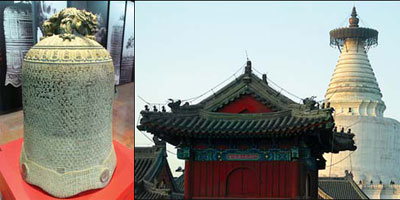There has never been a better time to brush up on Chinese culture, with free admission to museums under an initiative aimed at enticing people to these institutions in order to explore the country's grand history.
From March, some of Beijing's state-run museums will throw open their doors as part of a nationwide push putting China's 2,300 museums in the spotlight.

Left: The ancient bells of different times are on display in the Ancient Bell Museum. Right: The white pagoda highlights the Baita Temple.
The policy now being rolled out in the capital has already found success in 12 municipalities and provinces, with nearly 100 museums and memorial halls involved since the launch in late January.
The recent Spring Festival break became an opportunity for Beijing's Capital Museum to provide a teaser of the coming program, with half-price tickets offered to those unable to return home for the seven-day holiday.
Beijing's advance list of six museums to offer free entry included Haidian Museum, the Beijing Liao and Jin City Wall Museum and Beijing Elk Garden Museum. Every Wednesday, a dozen other popular museums offer free entry to 200 visitors by appointment, made via telephone to the venues in advance.
The free admission practice does not include those museums with ancient architecture of cultural relic value, for example the Palace Museum, according to the website of the Central People's Government of the People's Republic of China. The capacity of these museums is limited and the volume of visitors should be controlled.
At the National Library, reader's certificate application fees and entrance fees for the reading room were abolished earlier this month, while admission to lectures is now free. Readers can enjoy the service of the library by just showing their identity card. Charges have also been reduced for services such as photocopy, fax, retrieval of document and compact disc creation.

Clay sculptures form part of a folk cultural exhibition at the Capital Museum, which is providing free entry by appointment. Photos by Jiang Dong
"This measure marks the trend of free admission and service of Chinese public libraries," the library's director Zhan Furui, says.
All up, 24 public libraries in Beijing will adopt the free-entry policy from this month.
China's many museums, which includes 1,000 new institutions in recent years, attract just 150 million visitors per year, compared with 800 million museum-goers each year in the United States.
Early signs of the Chinese campaign have been promising. Nanjing Museum welcomed more than 7,000 people on February 8, its first day of free admission. Hubei Provincial Museum received an average of 6,000 visitors each day during the first week of the pilot program. During the Spring Festival, a great number of citizens spent their holidays in museums and memorial halls.
The Government plans to offer free admission to all its museums, memorial halls and national patriotism education bases by 2009, excluding cultural relics and historical sites. Finance vice minister Zhang Shaochun says operating expenses of national museums and memorial halls would be covered by the central budget, while institutions at the provincial level would be jointly supported by the central and local budgets, reported Xinhua News Agency.
Han Weichun, deputy director of the International School of the University of International Business and Economics, says the free-admission policy will promote Chinese history to the world. "The quality of public service represents the cultural level of a nation," Han says.
"As more and more foreign visitors enter the museums, they would know deeply of the brilliant culture of China and further spread it to their people."
The 2007 Beijing Museums Yearly Through Ticket is still valid.
Museums with free admission
Beijing Elk Garden Museum (北京麋鹿苑), Nanyuan, Daxing District, 8796-2107
Beijing Western Zhou Dynasty Yan Capital Site Museum (北京西周燕都遺址博物館), Dongjialincun, Liulihe, Fangshan District, 6139-3412
Museum of Western Han Tombs at Dabaotai (北京大葆臺西漢墓博物館), Dabaotai Village, Huangtugang, Fengtai District, 8361-3073
Beijing Liao and Jin City Wall Museum (北京遼金城垣博物館), You'anmen Dajie, Fengtai District, 6305-4991
Military Training Hall in Round City (北京團城演武廳), 1 Hongqi Village, Xiangshan Nanlu, Haidian District, 6259-4750
Haidian Museum (海淀博物館), 28-1 Zhonguancun Dajie, Haidian District, 5160-1042
Free admission by appointment
Capital Museum (首都博物館), 16 Fuxingmenwai Dajie, Xicheng District,6337-0505

Ancient Bell Museum in the Great Bell Temple (大鐘寺), A31 Beisanhuan Xilu, Haidian District,6255-0843
Beijing Art Museum (藝術博物館), Suzhou Jie, Xisanhuan Beilu, Haidian District, 6841-3380
Museum of Ancient Architecture (古代建筑博物館), inside Xiannongtan, Dongjing Lu, Xuanwu District,6304-5608
Museum of Stone Inscription Art (石刻藝術博物館), 24 Baishiqiao, Xizhimenwai, Haidian District, 6218-6081
Xu Beihong Memorial Hall (徐悲鴻紀念館),Xinjiekou Beidajie, Xicheng District, 6225-2042
Ancient Coins Museum (古代錢幣博物館), Bei'erhuan Zhonglu, Xicheng District,6202-9863, 6201-8073
Beijing Cultural Exchange Museum (文博交流館), 5 Lumicang Jie, Dongcheng District, 6525-3670, 6525-0072
Zhengyangmen Rostrum (正陽門), north of Qianmen Dajie,6522-9384
Laoshe Memorial Hall (老舍紀念館), Fengfu Hutong, Dengshikou Xijie, Dongcheng District,6559-9218, 6559-9218
Baita Temple (白塔寺), 171 Fuchengmenmei, Xicheng District,6616-6099
Dajue Temple (大覺寺), Bei'anhe, Haidian District,6246-1447, 6245-6163
Confucius Temple & The Imperial College (孔廟和國子監), 13 Guozijian Jie, Dongcheng District,6401-2118
(China DailyFebruary 23, 2008)